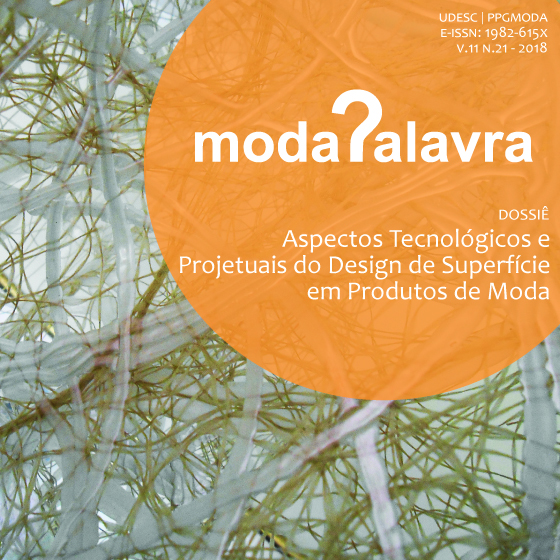Generative Design of Surfaces: an analysis of programming to develop of print textile design
DOI:
https://doi.org/10.5965/1982615x11212018005Keywords:
generative design, surface, fashion, surface designAbstract
The use of programming languages in the development of design process brings a new perspective to the methods. It opens opportunities for the designer to go beyond creation and drawing, attending the needs of the project through parameters stablished on a computer environment, generating solutions for the project. Furthermore, generative systems principles can be significantly expressive to integrating the design process and generating creative tools that evolve the limits of imagination with dynamic and customized solutions. The generative modeling considers programming knowledge for the conception of shape through geometric approaches aligned with complex systems that exhibit emergence and self-organization properties. On this scenario, this paper present and discuss the relationship with parametric and generative design for printed textile surfaces. As output, it is presented guidelines identifying how this field could improve with the new methods, and evolve its artistic practices for the creation of fashion products.Downloads
References
GUZELCI, Orkan Zeynel; GUZELCI, Handan. An Experimental Study On Generation Process of Geometric Patterns. In: 18h Generative Art Conference Proceedings, Venezia, 2015.
KENNING, Gail Joy. Pattern as Process: an aesthetic exploration of the digital possibilities for conventional, physical lace patterns. Tese (Doutorado em Belas Artes) - University of New South Wales, Sidney, 2007.
KHABAZI, Zubin Mohamad. Generative algorithms concepts and experiments: weaving. E-book. Disponível em: , USA, 2010
KHABAZI, Zubin Mohamad. Generative algorithms: using Grasshopper. E-book. Disponível em: , USA, 2012
MALIK, Aamina Karim. Mass Customization! An approach through Generative Design. In: 19h Generative Art Conference Proceedings, Milan, 2016.
McCORMACK, Jon; DORIN, Alan; INNOCENT, Troy. Generative design: a paradigm for design research. In: Redmond, J. et. al. (eds) Proceedings of Futureground, Design Research Society, Melbourne, 2004.
REAS, Casey; FRY, Ben. Processing: a programming handbook for visual designers and artists. The MIT Press, 2nd edition. Cambridge, 2014.
RUSSELL, Alex. Repeatless: transforming surface pattern with generative design. In: Shapeshifting Conference: Auckland University of Technology, Nova Zelândia, 2014.
RÜTHSCHILLING, Evelise Anicet. Design de superfície. Porto Alegre: Ed. da UFRGS, 2008
SCHWARTZ, Ada Raquel Doederlein. Design de superfície: por uma visão projetual geométrica e tridimensional. 2008. 200 f. Dissertação (Mestrado em design) - Universidade Estadual Paulista, Faculdade de Arquitetura, Artes e Comunicação. Disponível em: http://hdl.handle.net/11449/89726, 2008.
SHEA, Kristina; AISH, Robert; GOURTOVAIA, Marina. Towards integrated performance-driven generative design tools. Journal Automation in Construction 14, p. 253–264, 2005.
SILVA, Ana; CURRALO, Ana Filomena; FARIA, Pedro. Design têxtil – a influência da moda na criação de padrões. In: DESIGNA Proceedings - Conferência Internacional de Investigação em Design. Portugal, 2015.
STRUG, Barbara; ŚLUSARCZYK, Grażyna; GRABSKA, Ewa. Design patterns in generation of artefacts in required styles. In: 19h Generative Art Conference Proceedings, Milan, 2016.
TERZIDIS, Kostas. Algorithms for Visual Design Using the Processing Language. Wiley Publishing, Indiana: 2009.
VALÉRIO, José Henrique. Processing design: reflexões sobre design gerativo. Dissertação (Mestrado em Educação, Arte e História da Cultura) – Universidade Presbiteriana Mackenzie. São Paulo, 2013
VIEIRA, Anderson Koyama. Design generativo – estudo exploratório sobre o uso de programação no design. Monografia (Design) – USP, Universidade de São Paulo. São Paulo, 2014.
WOODBURY, Robert. Elements Of Parametric Design. Routledge, Taylor & Francis Group. New York, 2010
YU, Rongrong; GERO, John; GU, Ning. Impact of Using Rule Algorithms on Designers’ Behavior in a Parametric Design Environment: Preliminary Result from a Pilot Study. CAAD Futures, CCIS 369, pp. 13–22, 2013.
Downloads
Published
How to Cite
Issue
Section
License
Copyright (c) 2018 Mariana Araujo Laranjeira, João Fernando Marar, Luis Carlos Paschoarelli, Paula da Cruz Landim

This work is licensed under a Creative Commons Attribution-NonCommercial 4.0 International License.
When submitting an article for publication in ModaPalavra e-periodico, the author (s) agree (s) with the following terms:
- Authors maintain the copyright in their manuscripts and grant the journal the right of first publication, with work simultaneously licensed under the Creative Commons Attribution-NonCommercial 4.0 International, which allows sharing the work with the acknowledgment of authorship and the initial publication in the journal without payment ;
- Authors may use the same results in other publications after the first publication, provided that they indicate ModaPalavra e-journal as the original publication medium;
- Authors are authorized to take additional contracts, separately, only after the original publication in ModaPalavra e-journal, provided they indicate ModaPalavra e-journal as the original publication medium;
- Authors are allowed and encouraged to publish and distribute their work online (eg in institutional repositories or on their personal page), only after the editorial process and the first publication, provided they indicate ModaPalavra e-journal as the original publication medium;
- To indicate ModaPalavra e-journal as the original publication medium, authors should use the following text template: "This article was originally published by ModaPalavra e-periodical, under a CC BY NC license, in its volume [insert volume] number [insert number] in the year of [insert year], and can be accessed at: http://www.revistas.udesc.br/index.php/modapalavra/ ";
- The opinions expressed in the articles are the author’s sole responsibility, not necessarily reflecting the journal’s opinion. The publication of any material that is owned and held in copyright by a third party, including – but not limited to - articles, photos or drawings was previously authorized by their representatives to be published in ModaPalavra e-journal.









